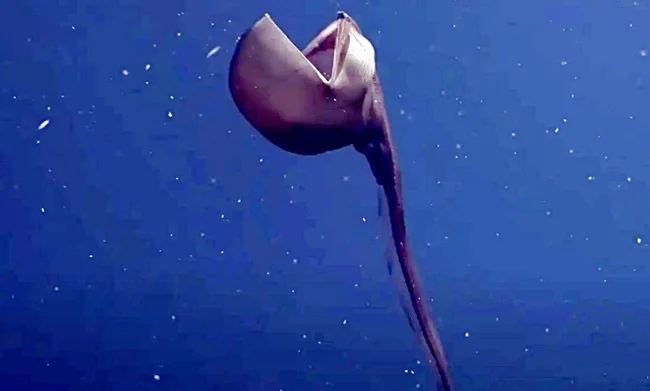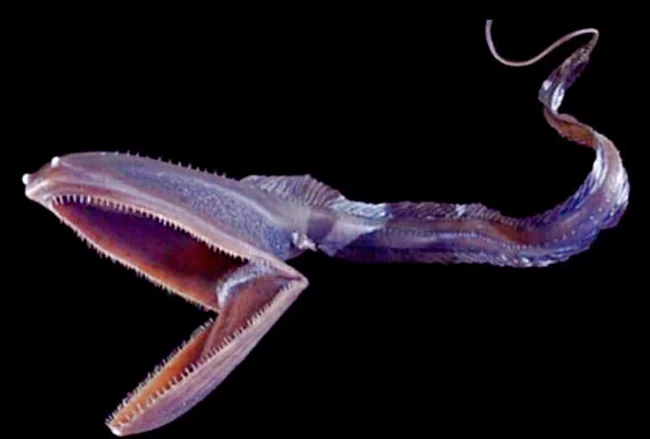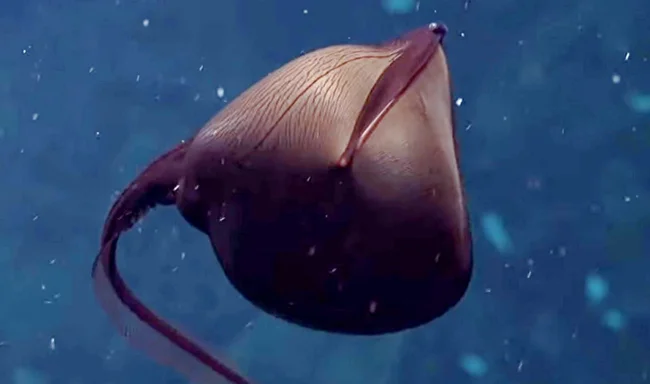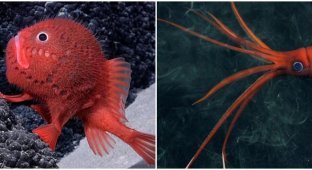Eerie, toothy, little-studied and elusive: where a strange creature that looks like an underwater mine hunts (3 photos)
According to experts, the vast expanses of the world's oceans have been explored by us even less than the surface of the Moon. It is no coincidence that it is in the depths of the sea and ocean that a huge number of amazing creatures are found, the very existence of which seems simply impossible. 
An example is the pelican-like bigmouth, whose head is from a quarter to a third of the entire body. In appearance, it resembles an underwater mine from World War II and is a terrible toothy ball with a long thin tail.
This is a species of rare ray-finned eel-like fish from the suborder Eurypharynx pelecanoides. Due to the presence of a huge suboral bag, they really look like a pelican, but the weight of the head can reach 70% of the weight of the entire body. These fish live at depths from 500 m to 3500 m, so it is very difficult for ordinary fishermen to catch them. They do not have such long gear. For this reason, researchers did not know about the existence of such a variety for a long time. Well, the shape of the strange creature resembles an eel, so the bigmouth is often called the pelican eel.
This species lives mainly in northern latitudes - in Iceland and Greenland, where there are specimens up to 180 cm long. But now the pelican-like bigmouth has been spotted in tropical areas of the world's oceans. There it has smaller dimensions - 60-80 cm. However, this "beast" is still quite scary and in rare cases of catching it, fishermen simply get scared and throw it overboard. Therefore, it was not possible to study it for a long time.
The discovery of a new species of fish was made only in 1882 by the French ichthyologist Leon Vaillant during a voyage on the ship "Travailleur". But initially it received its name Gastrostomus bairdii in honor of another researcher - Baird Fullerton. Later, the name Pelican eel appeared. However, biologists considered it unscientific and gave it the Latin name Eurypharynx pelecanoides or "large-mouthed pelican". 
This is a bottom fish, and given its deep-sea existence, it must withstand enormous pressure. This explains the structure of its body - huge massive jaws with strong bones and a flexible small body in the form of a tail. The pelican eel hunts crustaceans, shrimp and other inhabitants of the deep water. In this case, the prey is swallowed whole, along with the surrounding water, which after filtering comes out through the gill system. After absorption, the food immediately enters the digestive tract. The hunt can continue for many hours.
Another feature of the bigmouth, like some other deep-sea creatures, is the presence of a luminescent element at the tip of the tail that glows in the dark. There are several versions of the purpose of this organ. The first is that it serves as a lighting device for orientation in the dark depths of the water. The second is to lure prey into the light, the third is to attract females. And it is possible that all three versions are true. Such a universal organ of the body with a popular "three in one" function.
There are other interesting facts from the lives of the heroes of the article. For example, scientists have found that pelican eel fry grow close to the water surface. There is a lot of light and warmth there, which contributes to their rapid development. However, already at a length of 4 cm, the fry form a huge mouth and a thin tail, after which they move into the sea depths. 
The pelecanus also has unique sensory organs along the entire length of its body that can perceive vibrations of the environment. This allows it to identify potential prey, which distinguishes the predator from most other fish. Often, the pelecanus hunts from an ambush. This is facilitated by its inconspicuous coloring - from coal-black to gray-brown, depending on the habitat.

























